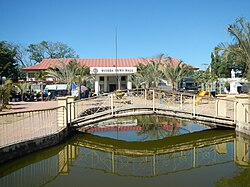Guimba, Nueva Ecija
| Guimba | ||
|---|---|---|
| Municipality | ||

Guimba Town Hall
|
||
|
||
 Map of Nueva Ecija showing the location of Guimba |
||
| Location within the Philippines | ||
| Coordinates: 15°39′29″N 120°46′8″E / 15.65806°N 120.76889°ECoordinates: 15°39′29″N 120°46′8″E / 15.65806°N 120.76889°E | ||
| Country | Philippines | |
| Region | Central Luzon (Region III) | |
| Province | Nueva Ecija | |
| District | 1st District | |
| Founded | 1897 | |
| Barangays | 64 | |
| Government | ||
| • Mayor | Jose Francis Steven M. Dizon | |
| Area | ||
| • Total | 245.29 km2 (94.71 sq mi) | |
| Population (2010) | ||
| • Total | 104,894 | |
| • Density | 430/km2 (1,100/sq mi) | |
| Time zone | PST (UTC+8) | |
| ZIP code | 3115 | |
| IDD : area code | +63 (0)44 | |
| Income class | 1st class; partially urban | |
| Website | guimba-ne |
|
Guimba is a first class municipality in the province of Nueva Ecija, Philippines. According to the 2010 census, it has a population of 104,894 people. It was incorporated by the King of Spain by virtue of a royal decree in 1897. It is known as the Organic Capital of Nueva Ecija and the Mushroom Capital of Nueva Ecija.
Guimba came from the Ilocano term 'Gebba' which was the process of heating molded clay pots in a pit until they turn reddish and durable. Tree stumps were made into large pieces of charcoal. The live charcoals were placed underneath the clay pots. After a few hours these were hardened and ready to bring out from the pit and ready for use.
The story goes, once a Spanish visited the place where most of the residents are engaged in pottery making. The foreigner stopped and asked the earth-bakers this question in a nasalized manner, 'Que lugar este?'. The foreigner asked what this place was. The natives misunderstood the question and were asked what they were doing, so they answered “GEBBA” pointing to the ground. The Spaniard repeated the word as they left the place “GHEBHA” after years have gone by the name of the place was hispanized into Guimba when the Spaniard founded the town as Pueblo en la provincia de Nueva Ecija. This pottery-making tradition is prevalent even in other barangays outside the central area of the town. An example is Barangay Pasong Intsik, which was named after 'old jars containing Chinese remains' were once found beneath a bridge.
The early Ilocano settlers brought with them the wonder image of Apo San Juan so they called the place San Juan de Guimba. In the American period, a resolution on the town separated the term 'Guimba' from 'Apo San Juan', thus its present name. But Apo San Juan remains as its Patron Saint. The pottery traditions of the indigenous settlers were later disintegrated and lost due to population influx from the Ilocos region and other areas in the south.
What is now the town of Guimba was once a vast ecological rainforest which was part of the Central Luzon Rainforest during precolonial time, before the arrival of the Spanish. The area is believed to be inhabited by no permanent communities, rather, it is inhabited by hunter-gatherer societies, mainly Ilonggots. The area was once part of the huge territory that the Empire of Tondo, with its capital in a much forested Manila. In the collapse of the Empire of Tondo after the subjugaton of Brunei, the area was transitioned into a free zone once again, where hunter-gatherers abounded. The area is also believed to once have been visited by migrating Aetas, Cordillerans, Ilokanos, and Ilonggots.
The first Ilocano settlers, arriving in wooden carts and horsebacks, cleared the thick forests and planted the first rice seeds in February 20, 1865, according to an old and brownish record found by Guimba's former Parish priest, Rev. Agustin "Gus" Polong, MSC. They called the area 'San Juan de Guimba' in honor of the patron saint the settlers brought from Ilocos, San Juan, and combined it with the pot-making industry called 'gebba' which they used to do in the old land. Since then, rice became the primary agricultural crop in the area. Due to this, it became the province of Nueva Ecija’s traditional top rice producing area in the 20th century.
...
Wikipedia


